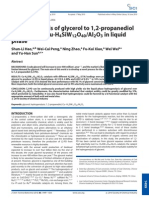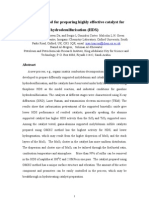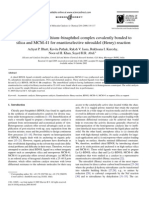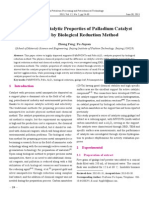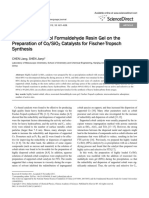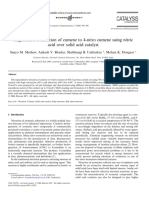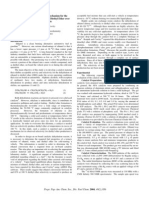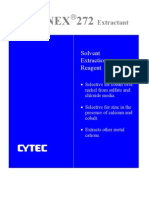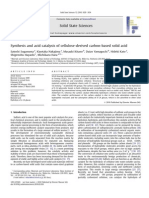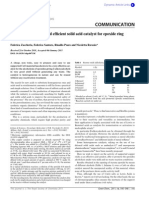B120432 1279 PDF
B120432 1279 PDF
Uploaded by
Carolina PalacioCopyright:
Available Formats
B120432 1279 PDF
B120432 1279 PDF
Uploaded by
Carolina PalacioOriginal Title
Copyright
Available Formats
Share this document
Did you find this document useful?
Is this content inappropriate?
Copyright:
Available Formats
B120432 1279 PDF
B120432 1279 PDF
Uploaded by
Carolina PalacioCopyright:
Available Formats
Effective Liquid-phase Nitration of Benzene Bull. Korean Chem. Soc. 2012, Vol. 33, No.
4 1279
http://dx.doi.org/10.5012/bkcs.2012.33.4.1279
Effective Liquid-phase Nitration of Benzene Catalyzed by a Stable Solid Acid
Catalyst: Silica Supported Cs
2.5
H
0.5
PMo
12
O
40
Gong Shu-wen,
*
Liu Li-jun, Zhang Qian, and Wang Liang-yin
Shandong Provincial Key Laboratory of Chemical Energy-Storge and Novel Cell Technology, School of Chemistry and
Chemical Engineering, Liaocheng University, Liaocheng 252059, China.
*
E-mail: gongshw@lcu.edu.cn
Received December 8, 2011, Accepted January 26, 2012
Silica supported Cs
2.5
H
0.5
PMo
12
O
40
catalyst was prepared through sol-gel method with ethyl silicate-40 as
silicon resource and characterized by X-ray diffraction, infrared spectroscopy, scanning electron microscopy,
nitrogen adsorption-desorption and potentiometric titration methods. The Cs
2.5
H
0.5
PMo
12
O
40
particles with
Keggin-type structure well dispersed on the surface of silica, and the catalyst exhibited high surface area and
acidity. The catalytic performance of the catalysts for benzene liquid-phase nitration was examined with 65%
nitric acid as nitrating agent, and the effects of various parameters were tested, which including temperature,
time and amount of catalyst, reactants ratio, especially the recycle of catalyst was emphasized. Benzene was
effectively nitrated to mononitro-benzene with high conversion (95%) in optimized conditions. Most
importantly, the supported catalyst was proved has excellent stability in the nitration progress, and there were
no any other organic solvent and sulfuric acid were used in the reaction system, so the liquid-phase nitration of
benzene that we developed was an eco-friendly and attractive alternative for the commercial technology.
Key Words : Liquid-phase nitration, Benzene, Solid acid catalyst, Supported, Sol-gel
Introduction
Nitrobenzene is known to be a starting material for pro-
ducing useful substances such as aniline, benzidine and
metanilic acid.
1,2
The commercial industrial production of
nitrobenzene involves nitration of benzene with a mixture of
sulfuric and nitric acids, which do not meet the environment-
friendly requirements of the modern chemical industry
processes. A major problem associated with the technology
is that the significant consumption of sulfuric acid generates
large amounts of wastes, which are very costly to treat.
3-5
To overcome this drawback, considerable efforts have
been put into developing of the heterogeneously catalyzed
liquid or vapor phase nitration of aromatic compounds using
solid acid catalysts.
6-11
Chaudhuri et al.
7
has studied the
catalytic activity of Al(H
2
PO
4
)
3
in nitration of benzene as an
solid acid catalyst with nitric acid (70%), and the yield of
nitrobenzene has been improved to 85%. Brei and coworkers
12
have reported the gas-phase nitration of benzene with 70%
HNO
3
catalytic by superacid WO
3
/ZrO
2
catalyst at 170
o
C
under atmospheric pressure, with the yield of nitrobenzene
in the range of 65-80% and selectivity for mononitrobenzene
of 99%. Although these solid acid catalysts showed good
catalytic properties in nitration progress, the recycling
results of these catalysts were not referred,
9-12
which are
important evaluation criterions for an excellent catalyst
applied in industrial production.
Heteropoly acids (HPAs), especially those of the Keggin
series, have attracted considerable interest as acid catalysts
for the clean synthesis of fine chemicals in heterogeneous
system.
13,14
However, solid HPAs can act as heterogeneous
catalysts in liquid phase only in non-polar solvents because
they are highly soluble in polar ones, which will result in
difficulty to recycle and reuse. Additionally these compounds
exhibit very low specific surfaces areas (1-10 m
2
g
1
)
15
and
moderate thermal stability, which limit their applications in
industrial chemical processes.
16
To overcome these handi-
caps, HPAs have been supported on different solid matrices,
such as silica,
16,17
MCM-41,
18
nanoparticle tin oxide,
19
titania
14
and so on. Preyssler type heteropoly acid, namely salts of
HPAs, were prepared by partially exchanging protons of the
parent HPAs with large cations, such as Cs
+
, Na
+
and NH
4
+
,
which could be water insoluble and present a rather high
surface area (> 100 m
2
/g),
20-22
such as the Cs
2.5
H
0.5
PW
12
O
40
possessed a considerable BET surface area 154 m
2
g
1
.
22
Therefore, as solid acid catalysts, the supported salts of
HPAs should be more competitive than those HPAs in
industrial chemical processes, while to the best of our
knowledge, there was little report about the evaluation of
supported salts of HPAs catalyst in nitration progress up to
now.
Previously, we have reported the application of ammonium
salt of 12-molybdophosphoric acid (AMPA) catalysts in the
liquid-phase nitration of benzene.
23
Those catalysts show
good catalytic activity in nitration, while there was a
decrease of activity after recycling for several times and the
stability of AMPA catalysts should improve in nitration
progress. In this work, silica supported Cs salt catalyst of 12-
molybdophosphoric acid (Cs
2.5
H
0.5
PMo
12
O
40
) was prepared
via sol-gel technology, and its catalytic activity has been
qualitatively evaluated in the liquid-phase nitration of benz-
ene using nitric acid under solvent-free conditions.
1280 Bull. Korean Chem. Soc. 2012, Vol. 33, No. 4 Gong Shu-wen et al.
Experimental
Synthesis of Cs Salt of Molybdophosphoric Acid. Cs
salt of 12-molybdophosphoric acid (Cs
2.5
H
0.5
PMo
12
O
40
,
which was abbreviated as CsPMA) was prepared by adding
the Cs
2
CO
3
solution dropwise to the 12-molybdophosphoric
acid solution under vigorous stirring according to the
literature method.
22
After 2 h stirring, the green precipitate
was obtained by dried at 110
o
C overnight.
Synthesis of Supported Cs Salt Catalysts. A series of
silica supported catalysts with varying molybdenum oxide
mass concentrations (5, 10, 20 and 30 wt %) were prepared
by the sol-gel technique. The mixed solutions of ethyl
silicate-40, distilled water and ethanol (volume ratio = 1:2:2)
were stirred at 70
o
C for 30 min to form clear solution. Then
the suspending aqueous solution of CsPMA, which prepared
in advance using the method mentioned above (dryness at
110
o
C was excepted) was added dropwise under constant
stirring at 70
o
C. And the stirring was conducted until the
transparent gel forms. After two days aging, these prepared
samples were dried at 110
o
C and collected. The catalysts
with different molybdenum oxide loading from 5 to 30 wt %
were referred to as CsPMA-x/SiO
2
(x = 5, 10, 20 and 30
wt %), which will be used for further characterizations and
activity estimation.
Physico-chemical Characterization. The BET surface
areas of catalysts were determined from nitrogen physi-
sorption measured on a Quantachrome Autosorb IQ-C
instrument at 196
o
C. Before the measurement, the samples
were evacuated at 200
o
C for 2 h. Powder X-ray diffraction
(XRD) spectra of catalysts were recorded on a X-ray
diffractometer (Beijing Purkinje General Instrument Co.
Ltd) with Ni filtered Cu K radiation ( = 1.542 ) and a
scanning range 2 of 5-80
o
. XRD patterns were attributed
using the JCPDS database. FT-IR spectra were taken using a
FT6700 instrument in KBr matrix in the range 400-4000
cm
1
. Scanning electron microscopy images (SEM) were
obtained with a JSM6380LV instrument to observe the
morphology of the prepared samples. The acidity of the
solid samples was measured by the potentiometric titra-
tion method. Certain amount of solid (0.5 g) was suspended
in acetonitrile and the system was then magnetically stirred
for 3 h at room temperature. Then the suspension was
titrated with a solution of 0.05 N n-butylamine in aceto-
nitrile, with the flowing rate of 0.05 mL/min. The variation
in the electrode potential was measured with an instrument
having a digital pH meter, using a standard calomel elec-
trode.
24
Catalytic Activity. All liquid-phase catalytic nitration
reactions were carried out in a batch reactor. In a typical run,
5 mL benzene, 15 mL nitric acid (65%) and 0.5 g catalyst
was added into a 100 mL round bottom flask at 70
o
C under
stirring. After stirring for 5 h, the catalyst was separated by
filtration, and the organic layer was analyzed off-line by gas
chromatography (FID, column: OV-101, 30 m length, 0.25
mm ID).
Results and Discussion
Catalyst Characterization. The powder XRD patterns of
the samples are shown in Figure 1. The patterns suggested
that the silica support and CsPMA-5/SiO
2
were in amorph-
ous phase. For the CsPMA-10/SiO
2
sample, the main peaks
were observed at 2 = 10.4
o
, 18.2
o
, 23.8
o
, 26.0
o
, 30.3
o
, 35.3
o
,
and 38.6
o
, which were assigned to the diffraction of
unsupported CsPMA. It is noteworthy that the intensities of
these diffraction peaks were increasing with the increase of
loadings. Compared with unsupported CsPMA, there was no
modification in the XRD patterns of the CsPMA/SiO
2
samples except the amorphous character at about 2 = 25
o
,
indicating that there was no structural change in the units of
CsPMA that are arranged on the amorphous silica support.
Figure 2 presents the FT-IR spectra of unsupported and
supported CsPMA samples. The spectra of CsPMA showed
the characteristic signature of Keggin structure with absorp-
Figure 1. XRD patterns of supported catalysts prepared by sol-gel
method.
Figure 2. FTIR spectrum of supported catalysts prepared by sol-
gel method.
Effective Liquid-phase Nitration of Benzene Bull. Korean Chem. Soc. 2012, Vol. 33, No. 4 1281
tion bands at 1063, 966, 868, and 800 cm
1
. For supported
CsPMA samples, the spectra shown a broad band around
3100-3600 cm
1
, which may be ascribed to adsorbed water
molecules. The absorption band at 1640 cm
1
was according
to HOH bending vibration of water. The broad absorption
band around 1090 cm
1
was attributed to SiO asymmetric
stretching vibrations of SiOSi bridges.
22
The informative
fingerprint about the presence of Keggin structure was also
given in FT-IR spectra of CsPMA-20/SiO
2
with two weak
characteristic band at 966 and 868 cm
1
that were not
observed in spectra of silica, indicating that CsPMA still
retained its Keggin structure after supported on silica by sol-
gel technology.
The SEM images of CsPMA and CsPMA-30/SiO
2
are
shown in Figure 3. It revealed that CsPMA was made up of
submicrometer sized free standing or aggregated sphere
shaped particles and the average particle size was in the
range of 0.5-1 m. Similar type of morphology was observed
in the case of CsPMA-30/SiO
2
and these sphere shaped
particles were well dispersed on the surface of plank shaped
silica support, which may conducive to the increase of
specific surface area.
Table 1 shows the BET surface areas of CsPMA-x/SiO
2
samples. As well known, neat H
3
PMo
12
O
40
has a low specific
surface area (< 10 m
2
/g).
15
The substitution of 2.5 H
+
in
H
3
PMo
12
O
40
by 2.5 Cs
+
brought about a change, the pre-
pared CsPMA has a surface area of 88 m
2
/g. For the series of
CsPMA-x/SiO
2
samples prepared by sol-gel technique, the
surface area of CsPMA-5/SiO
2
was 779 m
2
/g. Although the
values decreased gradually with the loadings increasing, the
surface area of CsPMA-30/SiO
2
was still 358 m
2
/g and
much higher than the pure CsPMA, indicating the sol-gel
method is effectively to increase the surface area of CsPMA
catalyst.
The acidity of these CsPMA-x/SiO
2
samples were measur-
ed by potentiometric titration technique with n-butylamine
as the titrant, which was recommended by Cid and Pecchi
24
to evaluate the strength and the total number of acid sites on
the surface of solid acid catalyst. The titration curves of the
electrode potential as a function of mL n-butylamine added
are shown in Figure 4. It can be found that as the acid sites of
these CsPMA-x/SiO
2
samples become neutralized, a buffer
behavior was more apparent, which in turn was related to the
volume of n-butylamine added. In order to further interpret
the results, it is suggested that the initial electrode potential
(E
i
) be taken as the maximum acidic strength of the surface
sites and the range where the plateau is reached can be
considered as the total number of acid sites.
25
On the other
hand, the acid strength of these sites may be classified
according to the following scale
25
: Ei > 100 mV (very strong
sites), 0 < Ei < 100 mV (strong sites), 100 < Ei < 0 mV
(weak sites) and E
i
< 100 mV (very weak sites). The Ei
values of CsPMA-x/SiO
2
samples with different loadings are
Figure 3. Scanning electron microscopy images of (a) CsPMA. (b)
CsPMA-30/SiO2.
Table 1. Physicochemical characterization, effects of loading on
nitration of benzene
Catalyst
BET surface
area (m
2
/g)
Ei (mV)
potentiometric
titration
Conversion
a
(%)
CsPMA-5/SiO2 779 161 69.1
CsPMA-10/SiO2 598 358 93.7
CsPMA-20/SiO2 526 375 95.1
CsPMA-30/SiO2 358 219 87.6
CsPMA 88 275 88.8
a
The reaction conditions are the ratio by volume of benzene: Nitric acid
is 1:3, the catalyst weight is 0.5 g, and the reaction is carried out at 70
o
C
under stirring for 5 h.
Figure 4. Potentiometric titration curves of supported catalysts.
1282 Bull. Korean Chem. Soc. 2012, Vol. 33, No. 4 Gong Shu-wen et al.
shown in Table 1. All CsPMA-x/SiO
2
samples exhibited
high Ei value, indicating these samples had very strong acid
sites. And the acid strength of the CsPMA-x/SiO
2
catalysts
increases as the loading increases to 20 wt %. On a further
increase of loading to 30 wt %, however, a decrease of acid
strength is observed, possibly due to the decline in surface
area and the aggregation of the catalysts with the high
loading.
Catalytic Activity. As catalyst of liquid-phase nitration of
benzene, pure CsPMA and CsPMA-x/SiO
2
with different
loadings were evaluated and the result is summarized in
Table 1. The reaction were carried out with the volume ratio
of benzene : nitric acid of 1:3 and the catalyst weight of 0.5
g. The reaction mixture was stirred for 5 h at 70
o
C. Take
CsPMA as catalyst, the conversion of benzene was about
89% and there were no other multi-nitro compounds formed
besides mononitro-benzene, indicating that CsPMA had
high catalytic activity and selectivity over nitrobenzene. In
other words, CsPMA exhibited excellent potential as the
alternative of sulfuric acid in the nitration progress of
benzene. For CsPMA-5/SiO
2
, the conversion of benzene
was 69%. With the increase of the loading, the conversion
increased rapidly and attained the maximum of 95% for
CsPMA-20/SiO
2
sample and then decreased gradually,
reaching 87.6% for CsPMA-30/SiO
2
. More significative
result could be observed from Table 1, the change of
catalytic activity was consistent with the change of acid
strength of pure and supported samples.
Compared with pure CsPMA, silica supported samples
with suitable loadings not only improve the catalytic
activity, but also to optimize the recycling performance of
the catalyst in reaction progress. The recycle of CsPMA-20/
SiO
2
was only by leaching from the reaction system and
dried at 110
o
C before used next time with fresh benzene and
nitric acid. The recycling result is shown in Table 2. The
conversion of benzene still reached 90% even after reusing
five times, indicating CsPMA-20/SiO
2
catalyst had excellent
stability under nitration reaction conditions. After being
reused for five times, the possible change of CsPMA-20/
SiO
2
catalyst in reaction progress was analyzed by XRD and
potentiometric titration technique. XRD pattern (Fig. 1) of
used CsPMA-20/SiO
2
catalyst was almost same as that of
before nitration and only these diffraction peaks ascribed
CsPMA were observed, indicating that there was no struc-
tural change in nitration progress. The potentiometric titra-
tion result indicated reused catalyst also had very strong acid
sites
(E
i
= 295 mV), which may be the main reason that this
catalyst still exhibited high catalytic activity after repetitious
usage. These results also demonstrated the initial idea that
combined the support technology and partially substitution
of protons by large cations, could improve the stability of
HPAs catalysts.
To deeply evaluate the catalytic performance of silica sup-
ported CsPMA catalyst, the effects of reaction parameters on
the nitration of benzene had been investigated in details,
such as the catalyst amount, temperature, time, the volume
ratio of benzene and nitric acid. CsPMA-10/SiO
2
was select-
ed as the evaluated catalyst. Figure 5 shows the effect of
volume ratio between nitric acid and benzene on the nitra-
tion reaction at 70
o
C over 0.5 g catalyst. The conversion of
benzene was 62% when the volume ratio of benzene and
nitric acid was 1:1, and it increased with the increase of the
amount of nitric acid. Almost completely conversion (98%)
with 100% selectivity of mononitrobenzene was obtained
when the volume ratio of nitric acid to benzene was increas-
ed to 4:1.
The effect of the catalyst amount (0.1, 0.3, 0.5, 0.7 and 1.0
Table 2. Influence of catalyst re-used on conversion of benzene
Used
times
Catalyst
Temper-
ature
(
o
C)
Benzene/
nitric acid
(V/V)
Time
(h)
Conver-
sion
(%)
1 CsPMA-20/SiO2 70 1:3 5 95.1
2 CsPMA-20/SiO2 70 1:3 5 93.6
3 CsPMA-20/SiO2 70 1:3 5 92
4 CsPMA-20/SiO2 70 1:3 5 90.9
5 CsPMA-20/SiO2 70 1:3 5 89.2
6 CsPMA-20/SiO2 70 1:3 5 90
Figure 5. Influence of volume ratio of nitric acid to benzene on
conversion of benzene.
Figure 6. Influence of catalyst amount on conversion of benzene.
Effective Liquid-phase Nitration of Benzene Bull. Korean Chem. Soc. 2012, Vol. 33, No. 4 1283
g) was investigated with the volume ratio of nitric acid to
benzene being 3:1 at 70
o
C for 5 h, and the result is presented
in Figure 6. The conversion of benzene increases from
55.6% to 93.7% with an increase in the catalyst amount from
0.1 to 0.5 g and then remained almost constant with further
increase of catalyst amount up to 1.0 g.
The effect of reaction time was studied at a volume ratio
of 1:3 using 0.5 g of CsPMA-10/SiO
2
catalyst at 70
o
C. As
illustrated in Figure 7, the percentage of conversion increas-
ed from 47.7% to 93.7% with an increase in reaction time
from 1 to 5 h. No notable increase of the conversion with
further increasing of the reaction time. Additionally, the pro-
duct was still only nitrobenzene after 6 h reaction, indicating
the selectivity towards nitrobenzene did not significantly be
affected by reaction time.
The effect of reaction temperature on the conversion of
benzene is shown in Figure 8. The reaction was carried out
in the temperature region 40-90
o
C over 0.5 g catalyst with
the nitric acid to benzene volume ratio of 3:1 for 5 h. The
conversion of benzene increased with the increase of reac-
tion temperature, indicating that the higher temperature
favored the acceleration of the reaction. But further increase
in reaction temperature up to 80
o
C obviously accelerated the
decomposition of nitric acid. As a result, the suitable
nitration temperature was 70
o
C.
Conclusions
An environment-friendly liquid-phase nitration of benzene
with mild conditions was developed. The Cs salt of phos-
phomolybdic acid exhibited good potential as alternative
catalyst of sulfuric acid in nitration of benzene, and the
catalytic activity can be effectively improved through the
loading of Cs
2.5
H
0.5
PMo
12
O
40
on silica support by sol-gel
method with ethyl silicate-40 as silicon resource. For the
supported catalyst, the Cs
2.5
H
0.5
PMo
12
O
40
particles with
Keggin-type structure were well dispersed on the surface of
silica, which resulted in the obvious increase of surface area
and acidity, and then optimized the catalytic performance,
especially the stability of catalyst in liquid-phase nitration of
benzene.
Acknowledgments. The authors are grateful for the sup-
port of the Doctor Foundation of Shandong Province
(BS2010CL011) and the National Basic Research Program
(2010CB234601).
References
1. Olah, G. A.; Malhotra, R.; Narang, S. C. Nitration: Method and
Mechanism; VCH: New York, 1989; pp 5-15.
2. Hu, Y.; Yang, J.; Yang, X.; Wang, G. Chinese J. Catal. 2009, 30,
891-895.
3. Chaubal, N. S.; Sawant, M. R. Catal. Commun. A 2007, 8, 845-
849.
4. Mao, W.; Ma, H.; Wang, B. J. Hazard. Mater. 2009, 167, 707-712.
5. German, A.; Akouz, T.; Figueras, F. J. Catal. 1994, 147, 163-170.
6. Adamiak, J.; Kalinowska-Alichnewicz, D.; Szadkowski, M.;
Skupiski, W. J. Hazard. Mater. 2011, 195, 195-200.
7. Bharadwaj, S. K.; Hussain, S.; Kar, M.; Chaudhuri, M. K. Appl.
Catal. A 2008, 343, 62-67.
8. Chaubal, N. S.; Sawant, M. R. Catal. Commun. 2007, 8, 845-849.
9. Kemdeoa, S. M.; Sapkalb, V. S.; Chaudharia, G. N. J. Mol. Catal.
A 2010, 323, 70-77.
10. Mishra, T. Catal. Commun. 2008, 9, 21-26.
11. Zolfigol, M. A.; Mirjalili, B. F.; Bamoniri, A.; Zarchi, M. A. K.;
Zarei, A.; Khazdooz, L.; Noei, J. Bull. Korean Chem. Soc. 2004,
25, 1414-1416.
12. Brei, V. V.; Prudius, S. V.; Melezhyk, O. V. Appl. Catal. A 2003,
239, 11-16.
13. Alsalme, A.; Kozhevnikova, E. F.; Kozhevnikov, I. V. Appl. Catal.
A 2008, 349, 170-176.
14. Kumbar, S. M.; Halligudi, S. B. Catal. Commun. 2007, 8, 800-
806.
15. Kozhevnikov, I. V. Catal. Rev. Sci. Eng. 1995, 37, 311-352.
16. Rocchiccioli-Deltcheff, C.; Aouissi, A.; Launay, S.; Fournier, M.
J. Mol. Catal. A 1996, 114, 331-342.
17. Rafiee, E.; Shahbazi, F.; Joshaghani, M.; Tork, F. J. Mol. Catal. A
2005, 242, 129-13.
18. Carriazo, D.; Domingo, C.; Martn, C.; Rives, V. J. Solid State
Chem. 2008, 181, 2046-2057.
19. Ahmed, A. I.; El-Hakam, S. A.; Abd Elghany, M. A.; Abo El-
Yazeed, W. S. Appl. Catal. A 2011, 407, 40-48.
20. Bamoharrama, F. F.; Heravi, M. M.; Roshani, M.; Gharib, A.;
Jahangir, M. J. Mol. Catal. A 2006, 252, 90-95.
Figure 7. Influence of reaction time on conversion of benzene.
Figure 8. Influence of reaction temperature on the conversion of
benzene.
1284 Bull. Korean Chem. Soc. 2012, Vol. 33, No. 4 Gong Shu-wen et al.
21. Heravi, M. M.; Khorasani, M.; Derikvand, F.; Oskooie, H. A.;
Bamoharram, F. F. Catal. Commun. 2007, 8, 1886-1890.
22. Parida, K. M.; Rana, S.; Mallick, S.; Rath, D. J. Colloid Interf. Sci.
2010, 350, 132-139.
23. Gong, S.; Liu, L.; Cui, Q.; Ding, J. J. Hazard. Mater. 2010, 78,
404-408.
24. Cid, R.; Pecci, G. Appl. Catal. A 1985, 14, 15-21.
25. Romanelli, G. P.; Autino, J. C.; Blanco, M. N.; Pizzio, L. R. Appl.
Catal. A 2005, 295, 209-215.
You might also like
- UNIT 5 Practice - KEYDocument14 pagesUNIT 5 Practice - KEYvDraq100% (1)
- CAPE Chemistry Unit 2 Paper 2 2017 AnswersDocument12 pagesCAPE Chemistry Unit 2 Paper 2 2017 Answersemanuel coates100% (9)
- Expt 6 - Chemical KineticsDocument5 pagesExpt 6 - Chemical KineticsNeil Tangara100% (2)
- Gong 2010Document5 pagesGong 2010mettyanaNo ratings yet
- Selective Hydrogenation of 2-Ethylanthraquinone Over An Environmentally Benign Ni-B/SBA-15 Catalyst Prepared by A Novel Reductant-Impregnation MethodDocument4 pagesSelective Hydrogenation of 2-Ethylanthraquinone Over An Environmentally Benign Ni-B/SBA-15 Catalyst Prepared by A Novel Reductant-Impregnation Methodrizanda93No ratings yet
- Hydrogenolysis of Glycerol To 1,2-PropanediolDocument5 pagesHydrogenolysis of Glycerol To 1,2-PropanediolKesavan GovinathanNo ratings yet
- Silicotungstic Acid Supported Zirconia: An Effective Catalyst For Esterification ReactionDocument7 pagesSilicotungstic Acid Supported Zirconia: An Effective Catalyst For Esterification ReactionJenny CórdobaNo ratings yet
- Environmental ProtectionDocument2 pagesEnvironmental Protectionid excaliburNo ratings yet
- J Cej 2018 07 072Document42 pagesJ Cej 2018 07 072EcNo ratings yet
- Vapour Phase Hydrogenation of Naphthalene On A Novel Ni-Containing Mesoporous Aluminosilicate CatalystDocument6 pagesVapour Phase Hydrogenation of Naphthalene On A Novel Ni-Containing Mesoporous Aluminosilicate Catalystioanaandra5690No ratings yet
- Co 1Document7 pagesCo 1정재선No ratings yet
- Ie2020608Document9 pagesIe2020608wiam wiamNo ratings yet
- Mohsin Siddique Et Al.,: J.Chem - Soc.Pak., Vol. 38, No. 03, 2016Document9 pagesMohsin Siddique Et Al.,: J.Chem - Soc.Pak., Vol. 38, No. 03, 2016Mohsin SiddiqueNo ratings yet
- SCI_Volume 24_Issue 3_Pages 1264-1271 (1)Document8 pagesSCI_Volume 24_Issue 3_Pages 1264-1271 (1)Sepehr SadighiNo ratings yet
- New Method For Preparing Highly Effective Catalyst For Hydrodesulfurisation (HDS)Document18 pagesNew Method For Preparing Highly Effective Catalyst For Hydrodesulfurisation (HDS)rancakNo ratings yet
- Dehydration of Methanol To Dimethyl Ether, Ethylene and Propylene Over Silica-Doped Sulfated ZirconiaDocument7 pagesDehydration of Methanol To Dimethyl Ether, Ethylene and Propylene Over Silica-Doped Sulfated Zirconiakrishna_nimeshNo ratings yet
- Applied Catalysis A: General: Sukriti Singh, Anjali Patel, Pravya PrakashanDocument10 pagesApplied Catalysis A: General: Sukriti Singh, Anjali Patel, Pravya PrakashanValentina Vargas VargasNo ratings yet
- Volume: I: Issue-3: Nov-Dec - 2010: ISSN 0976-4550Document6 pagesVolume: I: Issue-3: Nov-Dec - 2010: ISSN 0976-4550Sameera PatelNo ratings yet
- Size-Controlled and Large-Scale Synthesis of Organic-Soluble Ag Nanocrystals in Water and Their Formation MechanismDocument8 pagesSize-Controlled and Large-Scale Synthesis of Organic-Soluble Ag Nanocrystals in Water and Their Formation MechanismĐức Tùng NgôNo ratings yet
- Nickel Nanoparticles Catalyse Reversible Hydration of Carbon Dioxide For Mineralization Carbon Capture and StorageDocument6 pagesNickel Nanoparticles Catalyse Reversible Hydration of Carbon Dioxide For Mineralization Carbon Capture and StorageRahul GogiaNo ratings yet
- Binol On SilicaDocument8 pagesBinol On SilicaMinal ButalaNo ratings yet
- 1-PbSO4 Leaching in Citric Acid Sodium Citrate Solution and Subsequent ...Document10 pages1-PbSO4 Leaching in Citric Acid Sodium Citrate Solution and Subsequent ...Gregorio Antonio Valero VerdeNo ratings yet
- Research On Catalytic Properties of Palladium Catalyst Prepared by Biological Reduction MethodDocument7 pagesResearch On Catalytic Properties of Palladium Catalyst Prepared by Biological Reduction MethodTheia EosNo ratings yet
- Zhang 2014Document5 pagesZhang 2014oviabeautyNo ratings yet
- Condensation of Acetophenone To (Dypnone) Over Solid Acid CatalystsDocument9 pagesCondensation of Acetophenone To (Dypnone) Over Solid Acid CatalystsLutfiah Nur HidayatiNo ratings yet
- Effect of Resorcinol Formaldehyde Resin Gel On TheDocument8 pagesEffect of Resorcinol Formaldehyde Resin Gel On ThehoseiNo ratings yet
- Catalysis Communications: Ryan M. West, Mark H. Tucker, Drew J. Braden, James A. DumesicDocument4 pagesCatalysis Communications: Ryan M. West, Mark H. Tucker, Drew J. Braden, James A. Dumesicmagomago87No ratings yet
- Hydrogenation and Ring Opening of Naphthalene On Bulk and Supported Mo C CatalystsDocument11 pagesHydrogenation and Ring Opening of Naphthalene On Bulk and Supported Mo C Catalystsioanaandra5690No ratings yet
- 1 s2.0 S0926860X01006391 Main PDFDocument10 pages1 s2.0 S0926860X01006391 Main PDFAnish WaghuldeNo ratings yet
- Synthesis of Single-And Multi-Wall Carbon Nanotubes Over Supported CatalystsDocument12 pagesSynthesis of Single-And Multi-Wall Carbon Nanotubes Over Supported CatalystsThomas LewisNo ratings yet
- 2 AcetonitrileDocument7 pages2 Acetonitrilelimbachiya dakshNo ratings yet
- KawamuraDocument11 pagesKawamuraJens DSNo ratings yet
- EOR With Penn State Surfactants: T.G. ArfDocument11 pagesEOR With Penn State Surfactants: T.G. ArfSajad FalahNo ratings yet
- Regioselective Nitration of Cumene to 4-Nitro Cumene Using NitricDocument5 pagesRegioselective Nitration of Cumene to 4-Nitro Cumene Using Nitricrakshithbt2359gowdaNo ratings yet
- 49 2 Philadelphia 10-04 1181Document4 pages49 2 Philadelphia 10-04 1181lumengentiunNo ratings yet
- 9 Rami 9 19Document4 pages9 Rami 9 19rrraNo ratings yet
- Articulo ProyectoDocument9 pagesArticulo ProyectoHenry ArenasNo ratings yet
- Cyanex 272Document37 pagesCyanex 272partyweirdo100% (2)
- ����������HCl��Ӧ��̿��������ʧ�����Document8 pages����������HCl��Ӧ��̿��������ʧ�����Mosllem ShahmohammadiNo ratings yet
- s10562 019 02678 XDocument13 pagess10562 019 02678 XYoki YulizarNo ratings yet
- Liquid Phase Esteri®cation of Acrylic Acid With 1-Butanol Catalyzed by Solid Acid CatalystsDocument9 pagesLiquid Phase Esteri®cation of Acrylic Acid With 1-Butanol Catalyzed by Solid Acid CatalystsHolman SanabriaNo ratings yet
- Solvent Free Green Synthesis of 5-Arylidine Barbituric Acid Derivatives Catalyzed by Copper Oxide NanoparticlesDocument6 pagesSolvent Free Green Synthesis of 5-Arylidine Barbituric Acid Derivatives Catalyzed by Copper Oxide NanoparticlesbaskhemNo ratings yet
- Esterification of Higher Fatty Acids by A Novel Strong Solid AcidDocument5 pagesEsterification of Higher Fatty Acids by A Novel Strong Solid AcidGlorie Mae BurerosNo ratings yet
- 07-Catalytic Property of Vanadyl Pyrophosphates For SelectiveDocument10 pages07-Catalytic Property of Vanadyl Pyrophosphates For Selectiveali1860No ratings yet
- Catalytic Dehydration of Ethanol To Ethylene OverDocument7 pagesCatalytic Dehydration of Ethanol To Ethylene Overmilfa mutiara saniNo ratings yet
- Cita 2fotocatalisisDocument9 pagesCita 2fotocatalisisSkade JötunheimNo ratings yet
- Chemical Engineering Journal: Bholu Ram Yadav, Anurag GargDocument9 pagesChemical Engineering Journal: Bholu Ram Yadav, Anurag GargGaneshbhoiteNo ratings yet
- Science 16Document6 pagesScience 16Rồng IntelNo ratings yet
- J Ijhydene 2018 08 218Document11 pagesJ Ijhydene 2018 08 218Roni GustiwaNo ratings yet
- Polyoxometalates - 12-22Document14 pagesPolyoxometalates - 12-22b.abdenourNo ratings yet
- 38 1 Denver 03-93 0163Document9 pages38 1 Denver 03-93 0163farazaliraoNo ratings yet
- Articol EdtaDocument7 pagesArticol EdtaCami BratuNo ratings yet
- Communication: Cuo/Sio: A Simple and Efficient Solid Acid Catalyst For Epoxide Ring OpeningDocument4 pagesCommunication: Cuo/Sio: A Simple and Efficient Solid Acid Catalyst For Epoxide Ring Openingfedericasantoro81No ratings yet
- Over Monometallic in the Presence of CeO2 ZnSO4Document6 pagesOver Monometallic in the Presence of CeO2 ZnSO4Flora BayramovaNo ratings yet
- Justol - Bibliography 1-5Document7 pagesJustol - Bibliography 1-5Sofia JustolNo ratings yet
- Sulfated Zirconia: An e Cient Solid Acid Catalyst For Esterification of Myristic Acid With Short Chain AlcoholswDocument9 pagesSulfated Zirconia: An e Cient Solid Acid Catalyst For Esterification of Myristic Acid With Short Chain AlcoholswChau MaiNo ratings yet
- Adsorption of Crystal Violet Dye From Aqueous Solution Onto Zeolites From Coal Fly and Bottom AshesDocument13 pagesAdsorption of Crystal Violet Dye From Aqueous Solution Onto Zeolites From Coal Fly and Bottom AshessamsudinhafidNo ratings yet
- Hydrogenation of Ethyl Acetate To Ethanol Over Bimetallic Cu-Zn/Sio Catalysts Prepared by Means of CoprecipitationDocument6 pagesHydrogenation of Ethyl Acetate To Ethanol Over Bimetallic Cu-Zn/Sio Catalysts Prepared by Means of CoprecipitationAtul TripathiNo ratings yet
- Catalytic Decomposition of Cumene HydroperoxideDocument5 pagesCatalytic Decomposition of Cumene HydroperoxideLucas WatanabeNo ratings yet
- Active Sites of Ni2PSiO2 Catalyst For Hydrodeoxygenation of Guaiacol A Joint XAFS and DFT Study PDFDocument9 pagesActive Sites of Ni2PSiO2 Catalyst For Hydrodeoxygenation of Guaiacol A Joint XAFS and DFT Study PDFblackjack_027No ratings yet
- Synergistic Catalysis by Lewis Acid and Base Sites On Zro For Meerwein Ponndorf Verley ReductionDocument7 pagesSynergistic Catalysis by Lewis Acid and Base Sites On Zro For Meerwein Ponndorf Verley ReductionRiza SaidNo ratings yet
- Application of IC-MS and IC-ICP-MS in Environmental ResearchFrom EverandApplication of IC-MS and IC-ICP-MS in Environmental ResearchRajmund MichalskiNo ratings yet
- Nanoporous Catalysts for Biomass ConversionFrom EverandNanoporous Catalysts for Biomass ConversionFeng-Shou XiaoNo ratings yet
- Preparation and Purification of An Alkyl Halide: N. Galap, W. YbañezDocument3 pagesPreparation and Purification of An Alkyl Halide: N. Galap, W. YbañezyayNo ratings yet
- Carbocations and Carbanions- MCQDocument30 pagesCarbocations and Carbanions- MCQShunmugasundaram ArunachalamNo ratings yet
- Heat of Solution ReportDocument29 pagesHeat of Solution ReportFavour100% (1)
- Nitration (Lec 2 and 3)Document65 pagesNitration (Lec 2 and 3)Usama0% (1)
- Summary of Organic ReactionsDocument6 pagesSummary of Organic ReactionsAbudi Alsagoff100% (6)
- ExpoDocument349 pagesExpoamineNo ratings yet
- An Introduction To The Chemistry of D-Block ElementsDocument69 pagesAn Introduction To The Chemistry of D-Block ElementsrjasmiNo ratings yet
- Sn1 and Sn2 Reactions Write UpDocument6 pagesSn1 and Sn2 Reactions Write UpLevy Medina TrayaNo ratings yet
- Reactions of AlcoholsDocument8 pagesReactions of AlcoholsNirvan RampersadNo ratings yet
- 3 EnzymesDocument3 pages3 EnzymesTala AlkhawajaNo ratings yet
- Heterogeneous Catalysis and Solid Catalysts 1Document117 pagesHeterogeneous Catalysis and Solid Catalysts 1lotannaNo ratings yet
- Synthesis of BenzocaineDocument4 pagesSynthesis of BenzocaineBebi TanNo ratings yet
- Essay Type QuestionsDocument5 pagesEssay Type QuestionspoorviNo ratings yet
- Chemical Kinteics (Worksheet - 1)Document3 pagesChemical Kinteics (Worksheet - 1)priyanshnagar4120No ratings yet
- 1-Cell and Molecular Biology of PlantsDocument95 pages1-Cell and Molecular Biology of PlantsSubhash ChandNo ratings yet
- 7-q1-biology-1Document21 pages7-q1-biology-1pre123541974No ratings yet
- Solids Savvy: Solidify YourDocument17 pagesSolids Savvy: Solidify YoursvkatkarNo ratings yet
- Preliminar Concept of A Reaction System For Alkylation of Isobutane On A Solid CatalystDocument15 pagesPreliminar Concept of A Reaction System For Alkylation of Isobutane On A Solid CatalystGeraldin Ching FrancoNo ratings yet
- Protein ResearchDocument8 pagesProtein Researchsummerpark664No ratings yet
- Scientific Mother's Day PoemDocument2 pagesScientific Mother's Day PoemtoxxicpoiisonNo ratings yet
- The Chlorides of Carbon, Silicon and LeadDocument5 pagesThe Chlorides of Carbon, Silicon and LeadTadiwa KufakunesuNo ratings yet
- Paper 2 QP 2017-2022Document585 pagesPaper 2 QP 2017-2022Farrah IezzahNo ratings yet
- Kinetics, Energy & Equilibrium Mastery ChecklistDocument5 pagesKinetics, Energy & Equilibrium Mastery Checklistapi-245709841No ratings yet
- Electrochimica ActaDocument6 pagesElectrochimica ActabecobeliNo ratings yet
- 3.sample Paper Chemistry 12, Set-3, 2022-23Document10 pages3.sample Paper Chemistry 12, Set-3, 2022-23sachinNo ratings yet
- Applied Surface Science Advances: P.N. Belkin, S.A. Kusmanov, E.V. ParfenovDocument30 pagesApplied Surface Science Advances: P.N. Belkin, S.A. Kusmanov, E.V. ParfenovKaren AnnNo ratings yet
- Syllabus For CH115 General Chemistry IDocument7 pagesSyllabus For CH115 General Chemistry ISIT-BibleNo ratings yet





